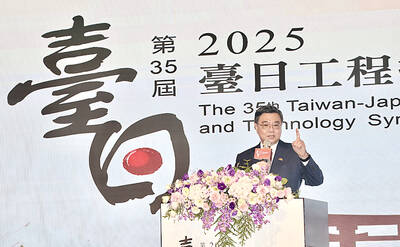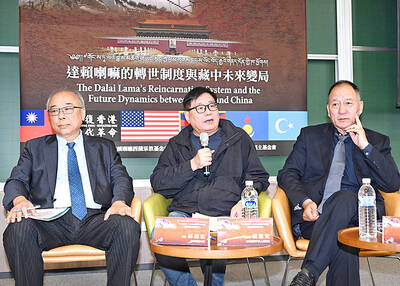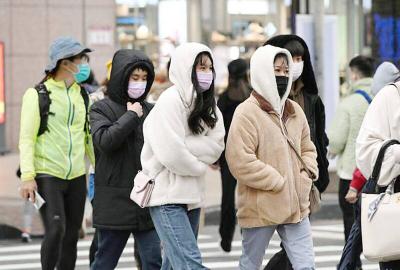Continued engagement is the best guarantee for maintaining peace and stability across the Taiwan Strait, said William Stanton, director of the Taipei Office of the American Institute in Taiwan (AIT), in an interview with a local newspaper on Thursday.
“Weapons are not the key” to cross-strait issues, Stanton was quoted by the Chinese-language United Daily News (UDN) as saying in the interview, which was published yesterday.
In the interview, Stanton reaffirmed that the US welcomes cross-strait engagement. However, he added, as Taiwan is a democratic country, it is up to the people of Taiwan to decide the speed and direction of such engagement.
Saying that quite a few Taiwanese people remain wary about the cross-strait detente, evidenced by the results of a series of local opinion surveys, Stanton said it is an issue that Taiwan’s current and future governments have to address.
Asked whether the US government would sell F-16C/D jet fighters to Taiwan, Stanton said Washington and Taipei are divided over this aspect of US arms sales to Taiwan.
In the safeguarding of national security, he said, military power is by no means the only defense.
Stanton said he didn’t think that any specific weapon system could be the golden key to solve an issue. No single weapon system could change the whole situation, he added.
On the timing of the signing of a bilateral extradition agreement, Stanton said his personal opinion was that it would take place next year.
He expressed hope that once the accord was struck, major Taiwanese fugitives with US citizenship or green cards would be included on a list of people subject to extradition.
Stanton said that the US government has been working very hard in preparation for the signing of the extradition agreement and that the FBI and the Drug Enforcement Administration, for instance, have been cooperating in drafting provisions of the accord.
He said that both Taiwan and the US have done a great deal to make the treaty a reality, but added it was a very complicated issue.
Besides differences in the legal systems on the two sides, extradition also involves some sensitive political issues, he said.
Stanton said that the extradition agreement must be approved by each side’s legislative branch. An existing bilateral judicial aid agreement was approved by Taiwan’s Legislative Yuan, but has not been sent to the US Congress for approval.
Touching on Taiwan’s aspirations to be included in the US’ visa waiver program (VWP), Stanton said it was not a political problem, but a legal issue.
“The truth is that we want you in,” Stanton said.
Nevertheless, he said that the US is now in a dilemma over the issue because, while the US truly intends to grant Republic of China passport holders visa waiver privileges, it also hopes Taiwan can live up to the conditions set forth by the program.
Noting that the VWP program has many requirements, Stanton said the major hindrance to Taiwan’s inclusion was its failure to demand that its citizens apply in person for their passports.
Last year, only 2.2 percent of US visa applications filed by Taiwanese passport holders were rejected, far lower than the standard 3 percent required to become eligible for visa-waiver privileges, Stanton said.
The figure indicates that the visa rejection rate is not a hurdle to Taiwan’s VWP inclusion, he added.
Citing media reports that human trafficking rings have smuggled Chinese citizens into the US by falsifying or tampering with Republic of China passports, Stanton said the problem is the absence of the requirement that Taiwanese must apply for their passports in person.
With cross-strait exchanges continuing to expand and the number of Chinese tourist arrivals increasing significantly, the problem could become even more serious, to the point that US immigration officers would routinely suspect incoming tourists with Taiwanese passports of hailing from China, Stanton said.
The large number of human trafficking cases has led US officials to exercise more caution than usual in immigration interviews with Republic of China passport holders, Stanton said.
Pointing out that it is normally the case around the world that people must apply in person for their passports, Stanton said he hoped Taiwan would adopt the practice soon.

ALIGNED THINKING: Taiwan and Japan have a mutual interest in trade, culture and engineering, and can work together for stability, Cho Jung-tai said Taiwan and Japan are two like-minded countries willing to work together to form a “safety barrier” in the Indo-Pacific region, Premier Cho Jung-tai (卓榮泰) yesterday said at the opening ceremony of the 35th Taiwan-Japan Modern Engineering and Technology Symposium in Taipei. Taiwan and Japan are close geographically and closer emotionally, he added. Citing the overflowing of a barrier lake in the Mataian River (馬太鞍溪) in September, Cho said the submersible water level sensors given by Japan during the disaster helped Taiwan monitor the lake’s water levels more accurately. Japan also provided a lot of vaccines early in the outbreak of the COVID-19 pandemic,

Kaohsiung Mayor Chen Chi-mai (陳其邁) on Monday announced light shows and themed traffic lights to welcome fans of South Korean pop group Twice to the port city. The group is to play Kaohsiung on Saturday as part of its “This Is For” world tour. It would be the group’s first performance in Taiwan since its debut 10 years ago. The all-female group consists of five South Koreans, three Japanese and Tainan’s Chou Tzu-yu (周子瑜), the first Taiwan-born and raised member of a South Korean girl group. To promote the group’s arrival, the city has been holding a series of events, including a pop-up

TEMPORAL/SPIRITUAL: Beijing’s claim that the next Buddhist leader must come from China is a heavy-handed political maneuver that will fall flat-faced, experts said China’s requirement that the Dalai Lama’s reincarnation to be born in China and approved by Beijing has drawn criticism, with experts at a forum in Taipei yesterday saying that if Beijing were to put forth its own Dalai Lama, the person would not be recognized by the Tibetan Buddhist community. The experts made a remarks at the two-day forum hosted by the Tibet Religious Foundation of His Holiness the Dalai Lama titled: “The Snow Land Forum: Finding Common Ground on Tibet.” China says it has the right to determine the Dalai Lama’s reincarnation, as it claims sovereignty over Tibet since ancient times,

Temperatures in some parts of Taiwan are expected to fall sharply to lows of 15°C later this week as seasonal northeasterly winds strengthen, the Central Weather Administration (CWA) said today. It is to be the strongest cold wave to affect northern Taiwan this autumn, while Chiayi County in the southwest and some parts of central Taiwan are likely to also see lower temperatures due to radiational cooling, which occurs under conditions of clear skies, light winds and dry weather, the CWA said. Across Taiwan, temperatures are to fall gradually this week, dropping to 15°C to 16°C in the early hours of Wednesday